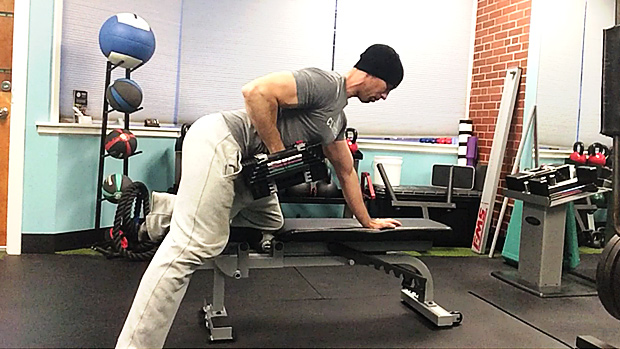The dumbbell row is a common exercise performed in gyms everywhere and is a splendid choice for anyone interested in building a back the size of Nebraska.1
It’s a staple in my own programming (and that of my clients) because it offers a bevy of other benefits – shoulder health, emphasizes unilateral strength, promotes increased eccentric loading (they’re superb for accentuated eccentric sets), and it’s undeniably versatile, to name a few.
However, it’s an exercise that’s often butchered in terms of its execution, and as a result many trainees lose out on all those benefits
I wanted to highlight a few of the more egregious culprits in today’s post.

There’s No One Perfect Way, and I’m Not Saying You’re Wrong
Let me set the record straight out of the gate.
This post is not meant to be the end-all-be-all-Tony’s-right-and-you’re-wrong-so-STFU answer to everything dumbbell row.
I’ll be the first to admit there are many nuances of the exercise I’m omitting from this post. Truth be told I didn’t want to write a 3000 word article on the dumbbell row and make people want to commit seppuku out of sheer boredom.
- 3ooo words on Why The Gummi Bears Were the Best Saturday Morning Cartoon of the 80’s = Pulitzer material.
- 300o words on the DB Row = someone toss me a sword.
That said, my main objective here is to 1) point out a handful of technique flaws I’ve observed over the span of a 15+ year coaching career, 2) suggest some “fixes” and 3) hopefully keep my pants on in the process.
DB Row Mistake #1: Not Pushing Away
Understandably, when we’re performing a DB Row we should emphasize and be cognizant of what the working/moving arm is doing (more on this below).
However, it’s important to recognize that the supporting/non-moving arm is also a major player and is very much involved in the proper execution of this exercise.
Mike Robertson has pointed this out in the past, and it makes a ton of sense. I watch a lot of people “hang out” on their supporting side when performing a DB Row…more or less “dumping” into that shoulder.
This places the scapulae in a precarious position – anteriorly tilted, often in more of a shruggy pattern – which isn’t doing anyone’s shoulder any favors.
Instead, you want to protract or “push away” on the supporting side for better positioning, stability, and, as a bonus, Serratus Anterior activation.
DB Row Mistake #2: The Path
Many people view the DB Row as two things:
- A straight up and down motion.
- An exercise that targets scapular retraction, namely the Rhomboids.
I view the DB Row as two things:
- More of an arc motion (forward and backward).
- An exercises that, yes, can (and kinda-sorta does) hit the rhomboids, but due to the increase line of pull (arc motion), is actually a superb exercise for maximal Lat engagement.
Strength coach Lee Boyce has hammered home this concept in the past, but it bears repeating here: the force angle of the DB Row – especially if it’s performed straight up and down – doesn’t lend itself as a great scapular retraction exercise.
Simply put: There are better options (Seated Row variations, bent over row, jumping into a live volcano).
Instead, you should treat the DB Row as more of Lat exercise.
Implementing more of a sweeping action or “arc” pattern with your arms allows you to match the fiber orientation of the Lats.
And that’s what it should target.
No diggidy, no doubt.
DB Row Mistake #3: Too Much ROM
More ROM isn’t always better.
A common mistake I often see trainees doing when performing a DB Row is allowing their elbow to travel too far past the midline of the body (glenohumeral extension).
Excessive glenohumeral extension (as what happens when the elbow travels past midline) can lead to excessive scapular anterior tilt and Anterior Humeral Glide, both of which will likely kill you.
Just kidding.
But they’re not going to make your shoulders (or elbows for that matter) feel great.
I like to cue my trainees to bring their elbows towards their hip or “back pocket” and that’s it. I’ll often have to place my hand just off the small of their back so they know when to stop.
Once they understand that, it’s makes all the difference in the world.
DB Row Mistake #4: Pinning the Shoulder Blade
Many people are cued to retract their shoulder blade at the top of the movement when they perform a DB Row.
Cool.
But then they keep it pinned there, in place, throughout the duration of a set.
Not cool.
And then this is how I react.
When I coach the DB Row I encourage people to feel a slight stretch at the bottom of the movement.
The shoulder blades are meant to move around the rib cage.
Pinning them in place can lead to a litany of other situations – like Downward Rotation Syndrome – which you’re better off avoiding.
There are situations where I may cue someone to hold a retracted position more, but it’s rare.
Don’t be afraid to let those bad-boys explore their full movement capability.
DB Row Mistake #5: Going Too Heavy
Here’s a nice rule of thumb: If you look like you’re having an epileptic seizure – or it looks like you’re using an industrial strength Shake Weight – when performing a DB Row you’re likely not doing it correctly (or gaining much benefit other than stroking your ego)
I understand there’s a time and place for body english.
I do.
But as Eric Cressey poignantly Tweeted the other day:
If you’re doing 1-arm rows with 110lb dumbbells but your deadlift is only 315lbs, I’m just going to put it out there that your ugly rows probably aren’t doing much for your deadlift. Or you need to stop skipping leg day.
— Eric Cressey (@EricCressey) August 10, 2018
Moreover, and as my colleague Chris Cooper succinctly reminded me of the other day, the DB Row is just as much of an upper back exercise as it is an ANTI-ROTATION exercise.

I prefer to encourage as rigid of a torso as possible during a set. There’s going to be “some” movement, mind you, but it shouldn’t be too prevalent.
When it is it’s often a sign someone is using too heavy of a load.
For a bit more of a the science and biomechanics of what I’m getting at – especially as it relates to the Resistance Curve and Strength Curve of rowing – I’d encourage you to check out THIS article by Nick Tumminello.
1100 Words
Boom shaka-laka.



